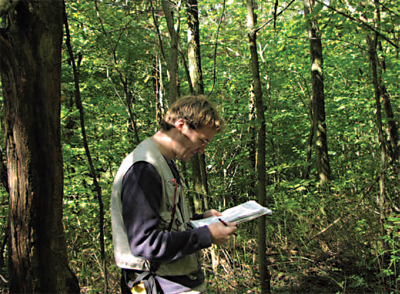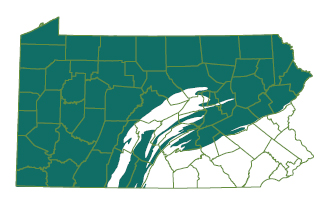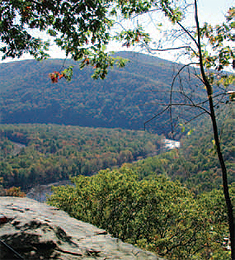Marcellus Shale – Sharing Science with Policymakers
As Marcellus shale activity increases, the Western Pennsylvania Conservancy is working with Pennsylvania citizens, landowners, businesses, policymakers and government leaders to help protect our region’s natural resources.
In addition to on-the-ground monitoring in local watersheds, providing information and scientific data about wildlife, water and forestland in our region and other initiatives, the Conservancy works closely with policymakers to help ensure that environmental factors and protections are being considered when decisions about Marcellus Shale natural gas extraction are made.

Ephraim Zimmerman, ecology and botany coordinator, reviewing his notes in the field.
Eight million acres of forestland and 20,000 miles of pristine rivers and streams within Pennsylvania’s Marcellus Shale region were the focus when Ephraim Zimmerman, the Conservancy’s ecology and botany coordinator with the Pennsylvania Natural Heritage Program, presented to the Marcellus Shale Advisory Commission’s Public Health, Safety and Environmental Protection working group in the spring.
Zimmerman’s presentation included research collected by WPC scientists that defined “ecologically important areas” in Pennsylvania — those that are the most biologically diverse. These areas include large patches of forest, important streams and wetlands and rare plant and animal species within these ecologically important areas.
Zimmerman also outlined a series of recommendations for avoiding or minimizing environmental disturbances to these important places. His presentation influenced the Commission’s unanimous adoption of several recommendations aimed at natural resource protection.
He also conveyed WPC’s recommendation that the commission consider a pre-planning process that identifies the future location of well pads and all ancillary infrastructure, such as pipelines and flowback ponds associated with wells. Zimmerman outlined how avoidance of key ecological attributes of an area such as floodplains, wetlands, streams, rare plants and animals and other significant habitats will protect these lands.

This map illustrates the location of the Marcellus Shale formation (blue) in Pennsylvania. The Marcellus Shale formation is believed to have been caused by a shallow sea that covered most of Pennsylvania during the Devonian Period over 380 million years ago.
Cynthia Carrow, WPC’s vice president of government and community relations, was the vice-chair of this working group. Through Carrow’s appointment, WPC was one of four nonprofit environmental organizations selected by Pennsylvania Governor Tom Corbett to serve on the commission. For more details on the commission outcomes, see the adjacent box.
In 2010, WPC scientists had provided research, data and technical expertise to The Nature Conservancy and Audubon Pennsylvania for use in a project that involved predicting the future impacts of various energy sources, including Marcellus Shale natural gas, in our region.
The Conservancy also is working with the Pennsylvania Bureau of Forestry to develop comprehensive best management practices to avoid and minimize impacts of Marcellus Shale gas development.
In addition, WPC has developed a resource document to assist landowners, partners and others in decision-making around natural gas exploration and extraction. The document, titled “Conservation Guidance for Landowners on Natural Gas Development,” can be found at WaterLandLife.org, along with WPC’s policy statement on Marcellus Shale gas drilling activity.
Environmental Protections Recommended in Marcellus Shale Advisory Commission Report

WPC is working to protect Western Pennsylvania’s special landscapes like the Youghiogheny River Gorge in Ohiopyle.
On July 22, members of the Marcellus Shale Advisory Commission reviewed and adopted almost 100 policy recommendations, which were forwarded to the governor for consideration in crafting policy and regulations related to Marcellus Shale gas extraction. The Western Pennsylvania Conservancy was one of four environmental nonprofit organizations with a representative on the commission.
While the Western Pennsylvania Conservancy did not support every recommendation in the Marcellus Shale Advisory Commission report, we agreed that many of the recommendations called for significant environmental improvements in state law and policy intended to effect better management of the shale gas industry.
The report recommended important protections to Western Pennsylvania’s streams, habitats and other natural resources, including:
- • expansion of well site setbacks from surface waters wetlands, water supplies and structures, and greater protections for floodplains and prohibiting where appropriate;
- • increased well site inspections;
- • greater information gathering and analysis in the permitting process to reduce impact on ecological resources;
- • improved tracking and reporting on the transporting, processing and treatment or disposal of wastewater;
- • measures designed to improve protection of rare, threatened and endangered species and important ecological areas;
- • using revenue from an impact fee for community-based environmental, conservation and outdoor recreation projects;
- • improved siting of pipelines to reduce surface disturbance and protect ecological and natural resources; and
- • requiring the same construction standards as for general construction activities.
The Commission’s full report, including all recommendations submitted by the working groups, can be found on the Pennsylvania Department of Environmental Protection’s website.
When a gift is a legacy, 75 years are only the beginning
Learn how you can make a difference for the future of Western Pennsylvania.
